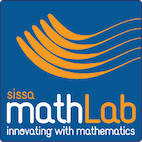|
Sunday
June 18 |
Monday
June 19 |
Tuesday
June 20 |
Wednesday
June 21 |
Thursday
June 22 |
Friday
June 23 |
| 9.00 - 10.30 Urban |
9.00 - 10.30 Kutz |
9.00 - 10.30 Urban |
9.00 - 10.30 Kutz |
9.00 - 10.30 Urban |
|
| COFFEE BREAK | COFFEE BREAK | COFFEE BREAK | COFFEE BREAK | COFFEE BREAK | |
| 11.00 - 12.30 Kutz |
11.00 - 12.30 Urban |
11.00 - 12.30 Urban |
11.00 - 12.30 Kutz |
11.00 - 12.30 Kutz |
|
| LUNCH | LUNCH | LUNCH | LUNCH | LUNCH | |
| 14.30 - 16.00 Urban |
14.30 - 16.00 Kutz |
EXCURSION | 14.30 - 16.00 poster/lab session |
||
| 19.30 DINNER |
19.30 DINNER |
19.30 DINNER |
19.30 DINNER |
19.30 DINNER |
Nathan Kutz
Data-driven models are critically enabling in many application areas where the underlying dynamics are unknown or only partially known, or where high-fidelity simulations are computationally expensive to generate. The ability to produce accurate, low-rank, proxy models enable dynamic models to transform the representation and characterization of such systems. Data-driven algorithms have emerged as a viable and critically enabling methodology that is typically empowered by machine learning algorithms. Indeed, there are a diversity of mathematical algorithms that can be used to produce data-driven models including (i) dynamic mode decomposition, (ii) sparse identification for nonlinear dynamics, and (iii) neural networks. Each of these methods are highlighted here with a view towards producing proxy, or reduced order, models that enable efficient computations of high-dimensional systems. Moreover, these methods can be used with direct measurement data, computational data, or both in generating stable representations of the dynamics.
Karsten Urban
Model reduction is a core technology in computational science, in particular in cases, where (i) the online computing facility is highly limited (CPU, storage, energy - cold computing), (ii) the same physical problem has to be solved for many different input data and (iii) the computation has to be extremely fast (real-time). As long as the physical problem is known and can be written in terms of a (Paremeterized) Partial Differential Equation ((P)PDE), the Reduced Basis Method (RBM) has been shown to allow for highly efficient model reduction and certified error control at the same time. However, by construction, the RBM is a linear approximation method, whose rate of approximation is given by the so-called Kolmogorov N-width. It is known that the N-width decays extremely fast (and thus allows for highly efficient numerical schemes) for large classes of elliptic and parabolic problems. On the other hand, however, there are counterexamples for the linear transport and the wave equation, where the decay is poor. Hence, alternatives are needed. We will consider three of them: (i) nonlinear model reduction by using a Ridge-function approximation; (ii) a combination of physical-based model reduction and data-driven models in terms of the Parameterized Background Data Weak (PBDW) framework and (iii) a Neural Network approach to solve PPDEs along with a wavelet-based error control.





